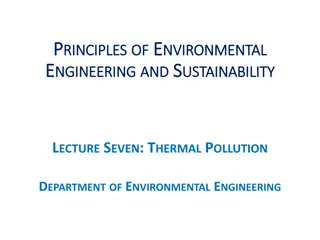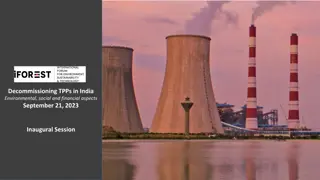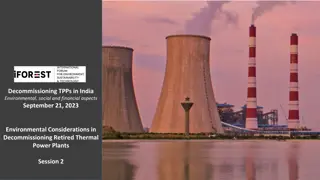Challenges and Implications of Transitioning Thermal Power Plants in India
A significant number of thermal power plants in India are set to be decommissioned in the coming years, leading to land availability, workforce displacement, and financial challenges. With a focus on just transition, addressing these implications is crucial to ensure a smooth shift towards more sustainable energy sources. Land utilization post-closure, labor market impact, and financial resource allocation are key areas that need attention to manage the transition effectively.
Download Presentation

Please find below an Image/Link to download the presentation.
The content on the website is provided AS IS for your information and personal use only. It may not be sold, licensed, or shared on other websites without obtaining consent from the author. Download presentation by click this link. If you encounter any issues during the download, it is possible that the publisher has removed the file from their server.
E N D
Presentation Transcript
A Just Transition of Thermal Power Plants Chandra Bhushan | October 12, 2022
126 units 11.9 GW decommissioned in India during March 2016-June 2021 due to techno-economic & commercial considerations 2.7 GW being replaced by new units 1.4 GW being repurposed for non- energy 7.8 GW await further decision/ action Visible shift in the approach of replacing old units with new, more efficient units This trend to intensify in the future as competition from clean energy increases. A new approach for managing coal closures is essential for India.
One-fifth of Indias coal capacity primed for decommissioning Retirement schedule of India s coal-based capacity 90,000 200 180 80,000 160 70,000 140 60,000 Number of units Capacity (MW) 120 50,000 100 9% capacity is 21-30 years old; 11% is 31-40 years; 2% is 41-57 years. Assuming a retirement age of 25 years: > 51 GW to retire by 2030. 40,000 80 30,000 60 20,000 40 10,000 20 - - 2022-2025 2026-2030 2031-2035 2036-2040 2041-2045 After 2045 Vintage of India s coal-based power generation fleet 25000 45 40 20000 35 Number of units 30 Capacity (MW) 15000 25 20 10000 15 10 5000 5 0 0 57 52 51 50 48 47 45 44 43 42 41 40 39 38 37 36 35 34 33 32 31 30 29 28 27 26 25 24 23 22 21 20 19 18 17 16 15 14 13 12 11 10 9 8 7 6 5 4 3 2 1 0 Age of Units Note: Assuming an aggressive coal-phase down scenario, where units are retired after 25 years of operations; Source: CEA; Global Energy Monitor
Implications - Land Coal-based power plants occupy an estimated land area of 1259 km2~ size of NCT of Delhi. Under a 25-year retirement scenario, about 200 km2 will be available in next 10 years. ESTIMATED LAND AREA TO BECOME AVAILABLE WITH POWER PLANT CLOSURES 86,056 68,503 2022-25 2026-30 45,273 44,665 36,039 2031-35 23,498 2036-40 23,246 12,312 12,230 2041-45 6,477 4,513 2,374 After 2045 CAPACITY OF FULLY DECOMMISSIONED PLANTS (MW) LAND AREA (HA) Source: iFOREST Estimates Ownership represents a mix of freehold & leasehold land, and high share of government-owned land (2/3rd) creating peculiar redevelopment challenges (risk of delayed/inefficient action in case of leasehold land, and risk of inaction in case of freehold land).
Implications - Labour 850,000 to 970,000 workers are estimated to be employed in the coal-based power sector. 70% of the workforce is informal labour, remaining 30% is a mix of departmental and contractual formal workforce. Under a 25-year retirement scenario, 2 lakhs workers will be affected by 2030. ESTIMATED NUMBER OF WORKERS TO BE AFFECTED DUE TO POWER PLANT CLOSURES At all decommissioned plant sites, informal and contractual labour compensation and reemployment is a major issue. Source: iFOREST Estimates
Implications - Financial resources Cost of demolition and scrap removal, cost of tendering Fly ash pond management (stabilization or sale) Compensation to all worker categories Plant overheads (electricity, rent, security, insurance, taxes etc.) Direct & indirect costs of TPP decommissioning Cost of clean-up C&D waste, hazardous waste management Cost of site decontamination & remediation Cost of just transition initiatives (additional social security support) O&M support to housing colony and other social infrastructure Rs 1,100 billion (at current prices) required for decommissioning of coal power plants (excluding the workforce and community JT costs) Under a 25-year retirement scenario, 25,000 crores required by 2030. ESTIMATED FUNDING REQUIREMENT FOR DECOMMISSIONING OF COAL-BASED POWER PLANTS IN INDIA Clearly earmarked funds and established liabilities important to ensure decommissioning action Source: iFOREST estimates
Implications - Environment Power plant dismantling involves dealing with a number of hazardous wastes and toxic materials, including Asbestos, PCBs, heavy metals like mercury, and other hazardous waste. Plant site requires remediation including managing accumulated fly ash and closure of ash ponds -- most challenging and expensive stage of decommissioning. Remediation vital to ensure that the plant site is free of pollutants and contaminants and that the site is restored for the subsequent planned use. What kind of regulatory framework would enable smooth decommissioning and remediation? How do we build expertise to undertake large-scale remediation and repurposing?
Thank You chandra@iforest.global

























